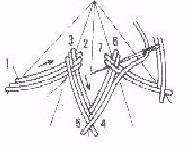L'art du Témari ... Points de Base - Temari’s Art….. basic stitch
Le point indispensable pour broder un témari est le point de chausson (en japonais : chidori kagari … et en anglais Herringbone stitch…) avec diverses variations, dont :
The most important stitch to embroider a temari is the herringbone stitch (in Japanese : chidori kagari …. And in French point de chausson…. With a lot of variations, like :
le point de chausson
herringbone stitch
- le point de Chrysanthème (kiku) qui se fait en brodant un point de chausson en zig-zag autour de la boule .
- the chrysanthemum stitch (kiku) is done by embroider a herringbone stitch in a zig-zag around the ball.
disposition du point de chrysamthème
position of the chrysanthemum
il y a aussi :
- le point de fuseau : au lieu de vous déplacer vers la droite, vous travaillez autour de la même ligne de division
- l’enroulement, qui, comme son nom l’indique consiste à enrouler le fil autour de la mari (boule) (en japonais mari kagari) en fixant le fil par quelque très petits points…
- le point en aiguille de pin (matsuba kagari) pour remplir les espaces entre des motifs pleins.
- et les points droits disposés de diverses façons.
Les autres points de broderie : point de tige, de nœuds, de mouche, de chaînette, de marguerite etc… sont utilisés parfois pour embellir les témaris, ainsi que les perles et les paillettes, mais ce sont des rajouts occidentaux , à ce qu’il semblerait.
En fait, rien qu’en utilisant les Divisions Simples en 3, 4, 5, 6, 8, 10 ,12,et 16 sections, les variations du point de base et en changeant les couleurs, on obtient déjà une variété de motifs assez impressionnante…
Si ensuite, vous y apprenez à construire les Divisions Complexes (qui multiplient les facettes de vos témaris)… là, le nombre de motifs différents devient comme les grains de riz du serviteur de l’empereur de Chine sur l’échiquier !… (vous connaissez cette histoire ? …)
Bref, chaque témari peut être différent, et la tradition japonaise « interdit » qu’un témari soit « parfait » pour ne pas rivaliser avec le travail de Dieu … ou de l’univers…
dans les compétitions organisées au Japon , s’il y a un témari parfait, des juges se chargent d’y ajouter un « défaut » (en fait, un point ajouté) …
Bien loin de notre esprit occidental, mais à méditer, je pense !
You have as well : the spindle stitch : instead of going from left to right, you go from right to left around the same division line.the winding around is, like its name say it, to wind the thread around the mari (ball) (in Japanese the “mari kagari) in fixing the thread with a few little stitches.- the pine needles stitch (matsuba kagari) to fill up the spaces between the motifs. And the straight stitches stitch where ever needed. The other stitches like : stem stitch, French knot, chain stitch, daisy stitch, etc…are use sometime to embellish the temaris, as well as beads and sequins, but apparently they are western’s add up. Actually, in using only simple divisions in 3, 4, 5, 6, 8, 10, 12 and 16 sections, with different basic stitches and different colours, we can have quite a big variety of motifs.
If after a while you will learn to built more complexes Divisions (who will multiply the sides of your temaris) then, then all your different motifs will be the size of the rice from the maid of the China’s Emperor check board. (do you know the story ???) To cut a story short, every temari might be different and the Japanese tradition forbid that any “temari” should be perfect, so men don’t equal God’s work….. or the universe…. In Japan they do organize competions, and if a temari is perfect, the judges take it on themselves to “add” a “fault” (in fact, they add a stitch…) Very far from our western spirit, but it is something to think about…. I think !
If after a while you will learn to built more complexes Divisions (who will multiply the sides of your temaris) then, then all your different motifs will be the size of the rice from the maid of the China’s Emperor check board. (do you know the story ???) To cut a story short, every temari might be different and the Japanese tradition forbid that any “temari” should be perfect, so men don’t equal God’s work….. or the universe…. In Japan they do organize competions, and if a temari is perfect, the judges take it on themselves to “add” a “fault” (in fact, they add a stitch…) Very far from our western spirit, but it is something to think about…. I think !
et toujours à suivre ....
and still more to come…..
Claude des Pyrénées



